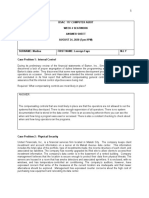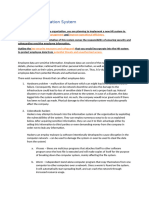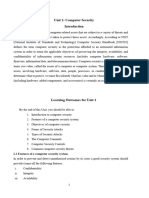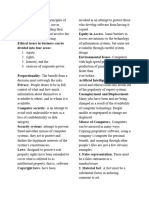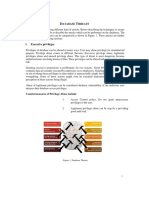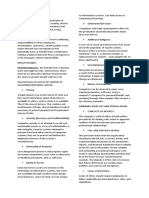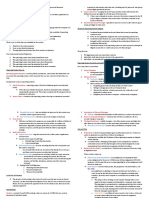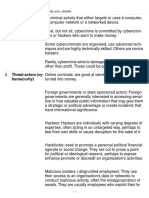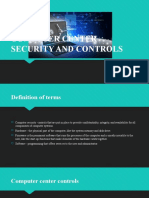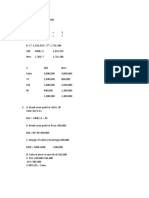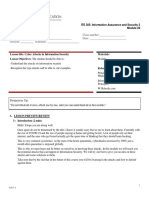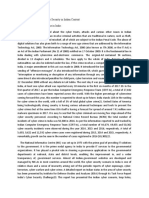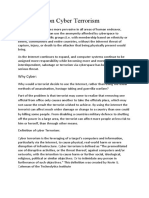Bsac 117 Computer Audit
Bsac 117 Computer Audit
Uploaded by
Leoreyn Faye MedinaCopyright:
Available Formats
Bsac 117 Computer Audit
Bsac 117 Computer Audit
Uploaded by
Leoreyn Faye MedinaOriginal Title
Copyright
Available Formats
Share this document
Did you find this document useful?
Is this content inappropriate?
Copyright:
Available Formats
Bsac 117 Computer Audit
Bsac 117 Computer Audit
Uploaded by
Leoreyn Faye MedinaCopyright:
Available Formats
1
BSAC 117 COMPUTER AUDIT
PRELIM QUIZ 1 AND 2
DUE DATE: September 9, 2020 (Wednesday) at 9:00 PM
Where to Submit: Google Classroom
ANSWER SHEET
SURNAME: Medina FIRST NAME: Leoreyn Faye M.I. Y
PRELIM QUIZ 1
QUESTIONS ANSWERS
1. What are internal controls? Internal control is a process resulted by plan management and
Explain briefly the importance of employees, and those charged with governance, and designed to
internal controls in safeguarding IT provide reasonable assurance regarding the achievement of
assets and records objectives in the reliability of financial reporting. Effective internal
control reduces the risk of asset loss, and helps ensure that plan
information is complete and accurate, financial statements are
reliable, and the plan’s operations are conducted in accordance
with the provisions of applicable laws and regulations.
2. Differentiate preventive controls A detective control is a type of internal control that seeks to
from detective controls uncover problems in a company's processes once they have
occurred while Preventive controls stand in contrast to detective
controls, as they are controls enacted to prevent any errors from
occurring
3. Give at least three (3) 1. Control environment - This is the attitude of management and
components of internal controls their employees regarding the need for internal controls.
and describe each briefly
2. Monitoring - This is the set of processes used by management to
examine and assess whether its internal controls are functioning
properly.
3. Control activities - This is the use of accounting systems,
information technology, and other resources to ensure that
appropriate controls are put in place and operating properly.
4. Explain at least three (3) 1. Management override - Someone on the management team
limitations of internal controls who has the authority to do so could override any aspect of a
control system for his personal advantage.
2. Collusion - Two or more people who are intended by a system of
control to keep watch over each other could instead collude to
2
circumvent the system.
3. Missing segregation of duties - A control system might have
been designed with an insufficient segregation of duties, so that
one person can interfere with its proper operation.
5. Define computer ethics Computer ethics are a set of moral standards that govern the use
of computers. It is society’s views about the use of computers,
both hardware and software.
6. When is an act fraudulent? An act is fraudulent when there is intentional deception to secure
(Hint: You may give the conditions unfair or unlawful gain, or to deprive a victim of a legal right.
of fraud.) (3 points)
Examples: Debit and Credit Card Fraud, Bank Account Takeover
Fraud and Stolen Tax Refund Fraud
7. Give at least three (3) examples 1. Viruses - computer code that can copy itself and spread from
of risks or threats to a company’s one computer to another, often disrupting computer operations
IT resources. Explain each briefly.
2. spam, scams and phishing - unsolicited email that seeks to fool
(6 points)
people into revealing personal details or buying fraudulent goods
3. staff dishonesty - theft of data or sensitive information, such as
customer details.
PRELIM QUIZ 2
COMPUTER
FRAUD DESCRIPTION
1 Malware Malware, or malicious software, is any program or file that is harmful to a
computer user. These malicious programs can perform a variety of different
functions such as stealing, encrypting or deleting sensitive data, altering or
hijacking core computing functions and monitoring users' computer activity
without their permission.
2 Cyber-harassment Cyber harassment refers to online harassment. Cyber harassment or bullying is
the use of email, instant messaging, and derogatory websites to bully or
otherwise harass an individual or group through personal attacks.
3 Hacking Hacking is an attempt to exploit a computer system or a private network inside a
3
computer. I is the unauthorized access to or control over computer network
security systems for some illicit purpose.
4 Denial-of-service Denial-of-Service (DoS) attack is an attack meant to shut down a machine or
attack network, making it inaccessible to its intended users. DoS attacks accomplish this
by flooding the target with traffic, or sending it information that triggers a crash.
In both instances, the DoS attack deprives legitimate users of the service or
resource they expected.
5 Salami Fraud Salami fraud is a technique by which cyber-criminals steal money or resources a
bit at a time so that there’s no noticeable difference in overall size. The
perpetrator gets away with these little pieces from a large number of resources
and thus accumulates a considerable amount over a period of time.
6 Logic Bombs Logic bomb is a sinister piece of code that is secretly inserted into a computer
network, operating system, or a software application. Like any other malicious
code, its primary goal is to wreak havoc on your system like steal or corrupt your
data, crash or overtake your device, or completely wipe your hard drive.
7 Trojan Horse Trojan horse or Trojan is a type of malware that is often disguised as legitimate
software. Trojans can be employed by cyber-thieves and hackers trying to gain
access to users' systems.
8 Phishing Scam Phishing is a type of social engineering attack often used to steal user data,
including login credentials and credit card numbers. It occurs when an attacker,
masquerading as a trusted entity, dupes a victim into opening an email, instant
message, or text message.
9 Web Jacking Web jacking derives its name from “hijacking”. Here, the hacker takes control of
a web site fraudulently. He may change the content of the original site or even
redirect the user to another fake similar looking page controlled by him.
10 Cyber stalking Cyberstalking is stalking that takes place using electronic devices or the internet.
It is the technological harassment directed towards a specific individual.
You might also like
- CEH: Certified Ethical Hacker v11 : Exam Cram Notes - First Edition - 2021From EverandCEH: Certified Ethical Hacker v11 : Exam Cram Notes - First Edition - 2021No ratings yet
- Bsac 117 Computer Audit Week 4 Seatwork Aug 24-StudentDocument7 pagesBsac 117 Computer Audit Week 4 Seatwork Aug 24-StudentLeoreyn Faye MedinaNo ratings yet
- Trellix Network Detection and Response Solution BriefDocument7 pagesTrellix Network Detection and Response Solution BriefOSAMAH ABU BAKERNo ratings yet
- Audit ProcedureDocument5 pagesAudit ProcedureLeoreyn Faye MedinaNo ratings yet
- Modus Operandi of Cyber CrimeDocument10 pagesModus Operandi of Cyber CrimeRanvidsNo ratings yet
- Lecture 1 Secure OrganizationDocument58 pagesLecture 1 Secure OrganizationKedir MohammedNo ratings yet
- Introduction To Cyber SecurityDocument11 pagesIntroduction To Cyber SecurityDeepika SharmaNo ratings yet
- Fraud, Ethics & Internal Controls: Chapter 3 Cont' Week 4: Lecture # 2Document27 pagesFraud, Ethics & Internal Controls: Chapter 3 Cont' Week 4: Lecture # 2Chand DivneshNo ratings yet
- Module II NotesDocument25 pagesModule II NotesmtamminiNo ratings yet
- Securing Information SystemDocument5 pagesSecuring Information Systemgpessay2020No ratings yet
- I. Issues or Challenges Pertaining To Computer SecurityDocument2 pagesI. Issues or Challenges Pertaining To Computer SecurityTrisha Camille Grospe AgraamNo ratings yet
- Bidgoli10e ch05Document35 pagesBidgoli10e ch05MeeraNo ratings yet
- Cyber SecurityDocument16 pagesCyber Securitythis.shahriarislamNo ratings yet
- BIS 321 Chapter One Part TwoDocument23 pagesBIS 321 Chapter One Part TwoEyob TemesgenNo ratings yet
- CSS4-Q1 Module 2Document10 pagesCSS4-Q1 Module 2Lielanie NavarroNo ratings yet
- Is Question N AnswerDocument83 pagesIs Question N AnswerGopal Sonune100% (9)
- IMT 306 Computer Security-1Document35 pagesIMT 306 Computer Security-1fareedahmusa5No ratings yet
- Cyber Crime Unit 1Document23 pagesCyber Crime Unit 1talha7667358058No ratings yet
- Information System SecurityDocument40 pagesInformation System SecurityDdfsffNo ratings yet
- Chapter 3 - Computer and Internet CrimeDocument34 pagesChapter 3 - Computer and Internet CrimePauline Bogador MayordomoNo ratings yet
- Computer Threat1Document5 pagesComputer Threat1Madison SmithNo ratings yet
- Itab 2Document2 pagesItab 2chiyoangeliqueNo ratings yet
- Chapter 09 IntrudersDocument38 pagesChapter 09 IntrudershajerpcNo ratings yet
- Lecture 2BDocument26 pagesLecture 2BTaguro ToguroNo ratings yet
- Classification of Computer Threats and AttacksDocument7 pagesClassification of Computer Threats and AttacksAnalyst AMMoonNo ratings yet
- Chapter 3 Computer and Internet CrimesDocument5 pagesChapter 3 Computer and Internet CrimesMeng Meng David100% (1)
- Finals Acis Reviewer TOPIC: Robot Network (BOTNET) Botnet (Short For Robot Network)Document7 pagesFinals Acis Reviewer TOPIC: Robot Network (BOTNET) Botnet (Short For Robot Network)lonely ylenolNo ratings yet
- cw3551 Dis Unit 2 NotesDocument18 pagescw3551 Dis Unit 2 Notesjaba123jabaNo ratings yet
- Reasons For Cyber CrimeDocument13 pagesReasons For Cyber CrimeShashi KantNo ratings yet
- QQ & SS AIS615 Test 1 March 2022Document1 pageQQ & SS AIS615 Test 1 March 2022ain madihahNo ratings yet
- Computer Security - Study NotesDocument19 pagesComputer Security - Study NotesPankaj RajNo ratings yet
- IntrudersDocument36 pagesIntrudersSmily TheresaNo ratings yet
- 1.1 List and Describe The Most Common Threats Against Contemporary Information SystemsDocument11 pages1.1 List and Describe The Most Common Threats Against Contemporary Information SystemsNguyễn BìnhNo ratings yet
- Information SecurityDocument28 pagesInformation SecuritycharlieNo ratings yet
- Cyber Security StrategiesDocument7 pagesCyber Security Strategiesdorkafakae6No ratings yet
- UNIT 2Document30 pagesUNIT 2saigangadharavirothiNo ratings yet
- Unit IDocument26 pagesUnit IafmatdpbjsslleNo ratings yet
- Cybersecurity and Risk ManagementDocument46 pagesCybersecurity and Risk ManagementSalsa MahadilaNo ratings yet
- Rahul Singh 21csmsa109Document18 pagesRahul Singh 21csmsa109cst01sm4311No ratings yet
- Information Assistant and SecurityDocument9 pagesInformation Assistant and SecurityWala LangNo ratings yet
- Chapter 1Document42 pagesChapter 1mofreh hogoNo ratings yet
- M 3Document9 pagesM 3busganonicole554No ratings yet
- Unit1 Part1-1Document12 pagesUnit1 Part1-1singh246018No ratings yet
- Controls For Information Security Instructor's Manual Learning ObjectivesDocument11 pagesControls For Information Security Instructor's Manual Learning Objectivesym5c2324No ratings yet
- Renewable2 0Document8 pagesRenewable2 073035537rishubrother95827594No ratings yet
- Excessive Privileges: Atabase HreatsDocument6 pagesExcessive Privileges: Atabase Hreats8816 jjclNo ratings yet
- Accist Reviewer 2Document6 pagesAccist Reviewer 2Angelie SaavedraNo ratings yet
- Security Part I: Auditing Operating Systems and NetworksDocument8 pagesSecurity Part I: Auditing Operating Systems and NetworksdelinfroNo ratings yet
- Cyberr Security and LawDocument3 pagesCyberr Security and LawadizriyalNo ratings yet
- CH 05 1 - UnlockedDocument50 pagesCH 05 1 - UnlockedjzNo ratings yet
- Cyber Attack ReportDocument14 pagesCyber Attack ReportKalika AryaNo ratings yet
- Cyber Security Introduction - Cyber Security BasicsDocument30 pagesCyber Security Introduction - Cyber Security BasicsNilesh Sharma100% (1)
- Cs 2Document11 pagesCs 2pomono1988No ratings yet
- Task 6 AnswersDocument5 pagesTask 6 AnswersolitantriciamaeNo ratings yet
- Sheet 1: 1 Prepared by Dr. Mohamed MoawedDocument7 pagesSheet 1: 1 Prepared by Dr. Mohamed MoawedNasis DerejeNo ratings yet
- Sort Question: What Is Computer Security?Document6 pagesSort Question: What Is Computer Security?bhoihitesh1400No ratings yet
- CYBERSECURITY ApplicationDocument5 pagesCYBERSECURITY ApplicationRakesh SawaiNo ratings yet
- Chapter Four: E-Commerce Security and CryptographyDocument21 pagesChapter Four: E-Commerce Security and Cryptographyiyasu ayenekuluNo ratings yet
- Lesson 2 - The Need For SecurityDocument45 pagesLesson 2 - The Need For Securityrazel gicaleNo ratings yet
- EhDocument7 pagesEhifgabhayNo ratings yet
- CIS Assign3Document3 pagesCIS Assign3Roisu De KuriNo ratings yet
- BIS 321 Chapter One Part ThreeDocument42 pagesBIS 321 Chapter One Part ThreeEyob TemesgenNo ratings yet
- Unit 1 CssDocument12 pagesUnit 1 CssKhushi SharmaNo ratings yet
- Cyber Crime 6Document10 pagesCyber Crime 6Nash Nicole LorenzoNo ratings yet
- BSAC 117 Computer Audit SEATWORK 1 (Ethics, Fraud and Internal Control) C. GonzagaDocument10 pagesBSAC 117 Computer Audit SEATWORK 1 (Ethics, Fraud and Internal Control) C. GonzagaLeoreyn Faye MedinaNo ratings yet
- Computer Center Security and ControlsDocument15 pagesComputer Center Security and ControlsLeoreyn Faye MedinaNo ratings yet
- SAC 117 Computer Audit FIRST TERM 2020-2021 C. GonzagaDocument1 pageSAC 117 Computer Audit FIRST TERM 2020-2021 C. GonzagaLeoreyn Faye MedinaNo ratings yet
- Term 1 SY 2020-2021 Midterm ExaminationDocument1 pageTerm 1 SY 2020-2021 Midterm ExaminationLeoreyn Faye MedinaNo ratings yet
- DBMSDocument12 pagesDBMSLeoreyn Faye MedinaNo ratings yet
- FINALSDocument1 pageFINALSLeoreyn Faye MedinaNo ratings yet
- Communication at WorkDocument28 pagesCommunication at WorkLeoreyn Faye MedinaNo ratings yet
- SEP21CADocument1 pageSEP21CALeoreyn Faye MedinaNo ratings yet
- Assignment#2Document2 pagesAssignment#2Leoreyn Faye MedinaNo ratings yet
- Tax Assign1Document4 pagesTax Assign1Leoreyn Faye MedinaNo ratings yet
- CVP, AVC, BudgetingDocument8 pagesCVP, AVC, BudgetingLeoreyn Faye MedinaNo ratings yet
- Identify and Discuss The Sources of Inter Group Conflict. Briefly Discuss How Goal Differences Can Lead To ConflictsDocument2 pagesIdentify and Discuss The Sources of Inter Group Conflict. Briefly Discuss How Goal Differences Can Lead To ConflictsLeoreyn Faye MedinaNo ratings yet
- Contract VS Quasi-ContractDocument2 pagesContract VS Quasi-ContractLeoreyn Faye MedinaNo ratings yet
- Discuss Other Business TaxDocument6 pagesDiscuss Other Business TaxLeoreyn Faye MedinaNo ratings yet
- ABC, Transfer, DifferentialDocument3 pagesABC, Transfer, DifferentialLeoreyn Faye MedinaNo ratings yet
- Course Syllabus Computer Audit Sy 2020-2021Document14 pagesCourse Syllabus Computer Audit Sy 2020-2021Leoreyn Faye MedinaNo ratings yet
- Ethics, Fraud, Internal Control PDFDocument62 pagesEthics, Fraud, Internal Control PDFLeoreyn Faye MedinaNo ratings yet
- Sas#4 Ite303Document8 pagesSas#4 Ite303John ken TalusanNo ratings yet
- Lec 3Document22 pagesLec 3Misbah IrumNo ratings yet
- Ethical Hacking Presentation NarendraDocument12 pagesEthical Hacking Presentation Narendrapankajalways04No ratings yet
- Dos AttackDocument11 pagesDos AttackbongNo ratings yet
- Top 5 HackersDocument5 pagesTop 5 Hackerscyber.warriorNo ratings yet
- The Continued Threat To Personal Data Key Factors Behind The 2023 IncreaseDocument25 pagesThe Continued Threat To Personal Data Key Factors Behind The 2023 IncreaseBharath VJNo ratings yet
- Dark Seul Attack Kill ChainDocument4 pagesDark Seul Attack Kill ChainmaxNo ratings yet
- Scribd Premium Cookies 01Document7 pagesScribd Premium Cookies 01rontechtipsNo ratings yet
- Computer and Network SecurityDocument52 pagesComputer and Network SecurityJb SadikNo ratings yet
- A Literature Review On Cyber Security in Indian ContextDocument2 pagesA Literature Review On Cyber Security in Indian ContextHarshal BharatiNo ratings yet
- CryptographyDocument8 pagesCryptographyVeso OjiamboNo ratings yet
- OSINT Handbook 2020 (Parte 2)Document199 pagesOSINT Handbook 2020 (Parte 2)ArthurwstNo ratings yet
- Lesson 11 Rules of NetiquetteDocument55 pagesLesson 11 Rules of NetiquetteIanna LandichoNo ratings yet
- Empowerment Technology: Quarter 1 - Module 2 "Online Safety, Security, Ethics and Etiquette"Document10 pagesEmpowerment Technology: Quarter 1 - Module 2 "Online Safety, Security, Ethics and Etiquette"Lielanie NavarroNo ratings yet
- DPlus HostsDocument11 pagesDPlus HostsCosmyn ZahariaNo ratings yet
- Al-Rimy Et Al - COSE - 2018 - Ransomware Threat Success Factors, Taxonomy and Countermeasures A Survey and Research DirectionsDocument23 pagesAl-Rimy Et Al - COSE - 2018 - Ransomware Threat Success Factors, Taxonomy and Countermeasures A Survey and Research DirectionsAleja MoraNo ratings yet
- Marriott International Data BreachDocument9 pagesMarriott International Data BreachbswijeNo ratings yet
- Types of Cyber CrimeDocument35 pagesTypes of Cyber CrimeRajwinder KaurNo ratings yet
- Evolution in The World of Cyber Crime: Phish Em!Document1 pageEvolution in The World of Cyber Crime: Phish Em!Marielle CaralipioNo ratings yet
- IS322 Week 6 TutorialDocument2 pagesIS322 Week 6 TutorialdiristiNo ratings yet
- Privacy, Security, and EthicsDocument26 pagesPrivacy, Security, and EthicsHưng Nguyễn MinhNo ratings yet
- Cyber Security: NAME: Priyanka Sudarshan Padhi Class: T. Y. B. Com Div: C ROLL NO.: 294Document27 pagesCyber Security: NAME: Priyanka Sudarshan Padhi Class: T. Y. B. Com Div: C ROLL NO.: 294Pooja PadhiNo ratings yet
- Case Study On Cyber TerrorismDocument8 pagesCase Study On Cyber TerrorismNitya Srivastava100% (1)
- Cyber Security Seminar Report PDF FreeDocument19 pagesCyber Security Seminar Report PDF Freediyis61035100% (1)
- Missing Functional Level Access Control: OWASP Web App Top 10Document6 pagesMissing Functional Level Access Control: OWASP Web App Top 10erickNo ratings yet
- 1.1.1.5 Lab - Cybersecurity Case StudiesDocument2 pages1.1.1.5 Lab - Cybersecurity Case StudiesRamdani AgusmanNo ratings yet
- @latest Hack V2.00 Super@ $hack Instagram Account$ #2020# # (Hack Insta Using Our Website #EASY) (NO Verification Instant Access) # (HACK INSTAGRAM)Document3 pages@latest Hack V2.00 Super@ $hack Instagram Account$ #2020# # (Hack Insta Using Our Website #EASY) (NO Verification Instant Access) # (HACK INSTAGRAM)Febrianto DozsantozNo ratings yet
- IBM X-Force Threat Intelligence Index 2021Document50 pagesIBM X-Force Threat Intelligence Index 2021mingwu2005No ratings yet

